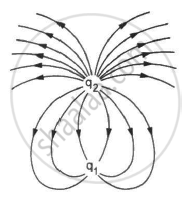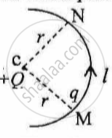Advertisements
Advertisements
प्रश्न
Choose the correct option.
Two charges of 1.0 C each are placed one meter apart in free space. The force between them will be
विकल्प
1.0N
9 × 109 N
9 × 10-9N
10N
उत्तर
9 × 109 N
Explanation:
F = `1/(4πε_0)("q"_1"q"_2)/"r"^2=9xx10^9xx(1xx1)/1` = 9 × 109 N
APPEARS IN
संबंधित प्रश्न
Explain the meaning of the statement ‘electric charge of a body is quantised’.
Why can one ignore quantisation of electric charge when dealing with macroscopic i.e., large scale charges?
It is now believed that protons and neutrons (which constitute nuclei of ordinary matter) are themselves built out of more elementary units called quarks. A proton and a neutron consist of three quarks each. Two types of quarks, the so called ‘up’ quark (denoted by u) of charge (+2/3) e, and the ‘down’ quark (denoted by d) of charge (−1/3) e, together with electrons build up ordinary matter. (Quarks of other types have also been found which give rise to different unusual varieties of matter.) Suggest a possible quark composition of a proton and neutron.
Does the charge given to a metallic sphere depend on whether it is hollow or solid? Give reason for your answer.
Consider the situation shown in the figure. What are the signs of q1 and q2? If the lines are drawn in proportion to the charges, what is the ratio q1/q2?

A point charge is taken from a point A to a point B in an electric field. Does the work done by the electric field depend on the path of the charge?
When a charged comb is brought near a small piece of paper, it attracts the piece. Does the paper become charged when the comb is brought near it?
In Figure 1 below, a charge Q is fixed. Another charge q is moved along a circular arc MN of radius r around it, from the point M to the point N such that the length of the arc MN = l. The work done in this process is:

figure 1
A metallic sphere A isolated from ground is charged to +50 μC. This sphere is brought in contact with other isolated metallics sphere B of half the radius of sphere A. The charge on the two-sphere will be now in the ratio
Answer the following question.
State the law of conservation of charge.
+2 C and +6 C two charges are repelling each other with a force of 12 N. If each charge is given -2 C of charge, then the value of the force will be ______
Let x = πR`(("P"^2 - "Q"^2)/2)`, where P, Q and Rare lengths. The physical quantity x is ______.
Conservation of charges in tribo electric charging _________.
Charge is quantized means ______.
Eight dipoles of charge of magnitude ± e are placed inside a cube. The total electric flux coming out of the cube will be:-
The dimensions of an atom are of the order of an Angstrom. Thus there must be large electric fields between the protons and electrons. Why, then is the electrostatic field inside a conductor zero?
A paisa coin is made up of Al-Mg alloy and weighs 0.75g. It has a square shape and its diagonal measures 17 mm. It is electrically neutral and contains equal amounts of positive and negative charges.
Treating the paisa coins made up of only Al, find the magnitude of equal number of positive and negative charges. What conclusion do you draw from this magnitude?
Consider a coin of Example 1.20. It is electrically neutral and contains equal amounts of positive and negative charge of magnitude 34.8 kC. Suppose that these equal charges were concentrated in two point charges seperated by (i) 1 cm `(∼ 1/2 xx "diagonal of the one paisa coin")`, (ii) 100 m (~ length of a long 6 building) and (iii) 106 m (radius of the earth). Find the force on each such point charge in each of the three cases. What do you conclude from these results?
